

Collections Online - Museum of New Zealand Te Papa Tongarewa. Overview At the end of the First World War an influenza pandemic swept across the world and through New Zealand over a short period from October to December 1918.
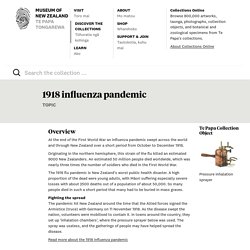
Originating in the northern hemisphere, this strain of the flu killed an estimated 9000 New Zealanders. An estimated 50 million people died worldwide, which was nearly three times the number of soldiers who died in the First World War. Flupandemicpresentation. A 100 years ago today – the likely first NZ death from the 1918 influenza pandemic – Public Health Expert, University of Otago, New Zealand. Prof Nick Wilson, Dr Jennifer Summers, Prof Michael Baker The 1918 influenza pandemic began to kill New Zealanders 100 years ago today.
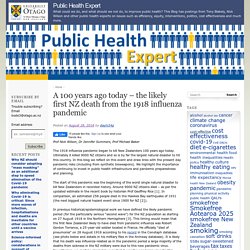
Ultimately it killed 9000 NZ citizens and so is by far the largest natural disaster to hit this country. In this blog we reflect on this event and draw links with the present day pandemic risks (including from synthetic bioweapons). Death by numbers. : Lessons learned from the great influenza pandemic of 1918. In 1918, the great influenza pandemic killed 9000 New Zealanders in the space of just two months.

Coming at the end of World War I, it took a heavy toll on an already stressed population. Death struck unevenly - some communities were destroyed, while others were unscathed. Lessons learned from that crisis remain the bedrock of our pandemic response today. Kirsty Johnston spoke to historian Geoffrey Rice, author of the book Black November: The 1918 influenza pandemic in New Zealand, about what 1918 can teach us in the age of coronavirus.
Rice, an Emeritus professor at the University of Canterbury, spoke with us from Christchurch, where he was about to go into self-isolation after his son returned from university in Japan. New Zealand's worst disease-disaster: 100 years since the 1918 influenza pandemic. University of Canterbury Emeritus history professor Geoffrey Rice is the author of Black Flu 1918: the Story of New Zealand's Worst Public Health Disaster, Canterbury University Press, 2017.
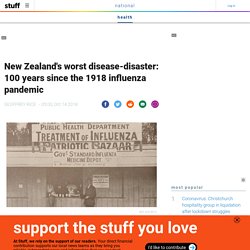
On the 100-year anniversary of the flu that wiped out thousands of Kiwis, he recounts the misery. It took four years for the First World War to kill 18,000 New Zealand soldiers. Yet in just six weeks, from early November to mid-December 1918, at least 9000 New Zealand civilians and soldiers died from influenza and pneumonia in the so-called 'Spanish Flu' pandemic.
This was New Zealand's share of a global calamity. The most reliable estimates place the death toll at between 50 and 60 million, or about 3 per cent of the global population at that time. We know nothing about large parts of Africa and Asia, and may never know, for simple lack of evidence. READ MORE: *One hundred years after the Spanish Flu, where are the memorials? It was a seriously bizarre pandemic. Influenza. It remains the country’s worst natural disaster.

Here there are no names by which to remember these people, nothing to say what part they played in their families and in our history. You can tell something was amiss—that here was a situation so urgent that the normal courtesies of death were waived. Remembering the 1918 influenza pandemic: national survey of memorials and scope for enhancing educational value around pandemic preparedness. Pandemics of influenza and other infectious diseases remain a serious global threat, requiring ongoing preparations by all countries.
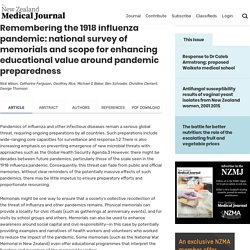
Such preparations include wide-ranging core capacities for surveillance and response.1,2 There is also increasing emphasis on preventing emergence of new microbial threats with approaches such as the Global Health Security Agenda.3 However, there might be decades between future pandemics, particularly those of the scale seen in the 1918 influenza pandemic. Consequently, this threat can fade from public and official memories. Without clear reminders of the potentially massive effects of such pandemics, there may be little impetus to ensure preparatory efforts and proportionate resourcing.
Memorials might be one way to ensure that a society’s collective recollection of the threat of influenza and other pandemics remains. Searches to identify memorials Local networks and memorial site visits Comparisons with other memorials. Immunisation Advisory Centre. The 11th of November 2008 commemorated the 90th anniversary of the global influenza pandemic or ‘Spanish Flu’ which coincided with the end of the first world war.
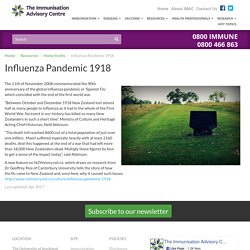
"Between October and December 1918 New Zealand lost almost half as many people to influenza as it had in the whole of the First World War. No event in our history has killed so many New Zealanders in such a short time”. Ministry of Culture and Heritage Acting Chief Historian, Neill Atkinson. “The death toll reached 8600 out of a total population of just over one million. Maori suffered especially heavily with at least 2160 deaths. A new feature on NZHistory.net.nz which draws on research from Dr Geoffrey Rice of Canterbury University tells the story of how the flu came to New Zealand and, once here, why it caused such losses. : Is NZ facing a repeat of the 1918 flu pandemic? In 1918, the flu pandemic killed 9000 New Zealanders.
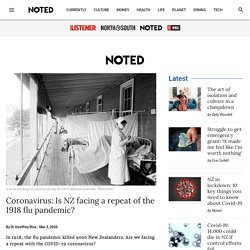
Are we facing a repeat with the COVID-19 coronavirus? The short answer is no. COVID-19 is a different virus, though its attack on the human respiratory system is very similar to that of pandemic influenza. It also spreads in a similar way, through droplet infection from coughs and sneezes, and hand-to-hand transmission from surfaces such as handrails, taps and doorknobs. Coronaviruses are typically responsible for many winter colds and our immune systems have learned to cope with them, but a new strain such as COVID-19 is more dangerous because of its novelty. Another answer to the question would be that history never repeats. The influenza era, 1890s to 1920s. The 1890s to the 1920s were dominated by two influenza pandemics (1890–94 and 1918), with annual epidemics in between.
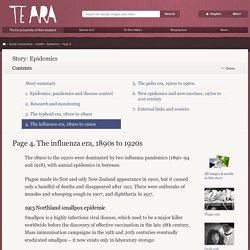
Plague made its first and only New Zealand appearance in 1900, but it caused only a handful of deaths and disappeared after 1911. There were outbreaks of measles and whooping cough in 1907, and diphtheria in 1917. 1913 Northland smallpox epidemic Smallpox is a highly infectious viral disease, which used to be a major killer worldwide before the discovery of effective vaccination in the late 18th century. Mass immunisation campaigns in the 19th and 20th centuries eventually eradicated smallpox – it now exists only in laboratory storage. Small pox, big effect Smallpox is at first hard to distinguish from chickenpox, but it is much more dangerous, and as the disease develops two types of case can be fatal: when the spots bleed and become septic, or if the rash extends into the air-passages, blocking the windpipe. Centenary of the 1918 flu pandemic. An influenza pandemic (world-wide epidemic) struck New Zealand between October and December 1918, just at the war’s end.
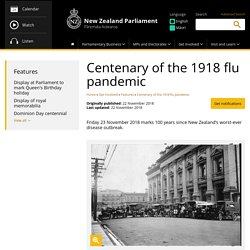
No other event has killed so many New Zealanders in so short a time. In only two months, about 9,000 New Zealanders died — about half as many as in the whole of the First World War. Around the world, the pandemic infected hundreds of millions, and killed almost three times as many as WWI. Origins of the infection Historians now believe the pandemic was related to swine flu.
Many people believed the virus arrived in New Zealand aboard the RMS Niagara with the Prime Minister, William Massey, and Finance Minister, Sir Joseph Ward, who were returning from meeting the Imperial War Cabinet in London. Influenza Pandemic. 1918 Influenza Pandemic. Influenza Pandemic 1918 - Explore topics - Auckland War Memorial Museum. The 1918 flu pandemic - The 1918 influenza pandemic. In the early 21st century, anxiety over the danger of Influenza A virus subtypes H5N1 (avian flu) and H1N1 (swine flu), and the COVID-19 coronavirus, has revived interest in New Zealand's worst disease outbreak, the lethal influenza pandemic that struck between October and December 1918. In two months New Zealand lost about half as many people to influenza as it had in the whole of the First World War. No other event has killed so many New Zealanders in such a short time. Many people believed that this severe form of influenza was borne by ‘a deadly new virus’ that arrived on the Royal Mail liner Niagara on 12 October, but this is unlikely to have been the case.
However the pandemic arose, by the time it eased in December about 9000 New Zealanders had died. Māori suffered heavily, with about 2500 deaths.